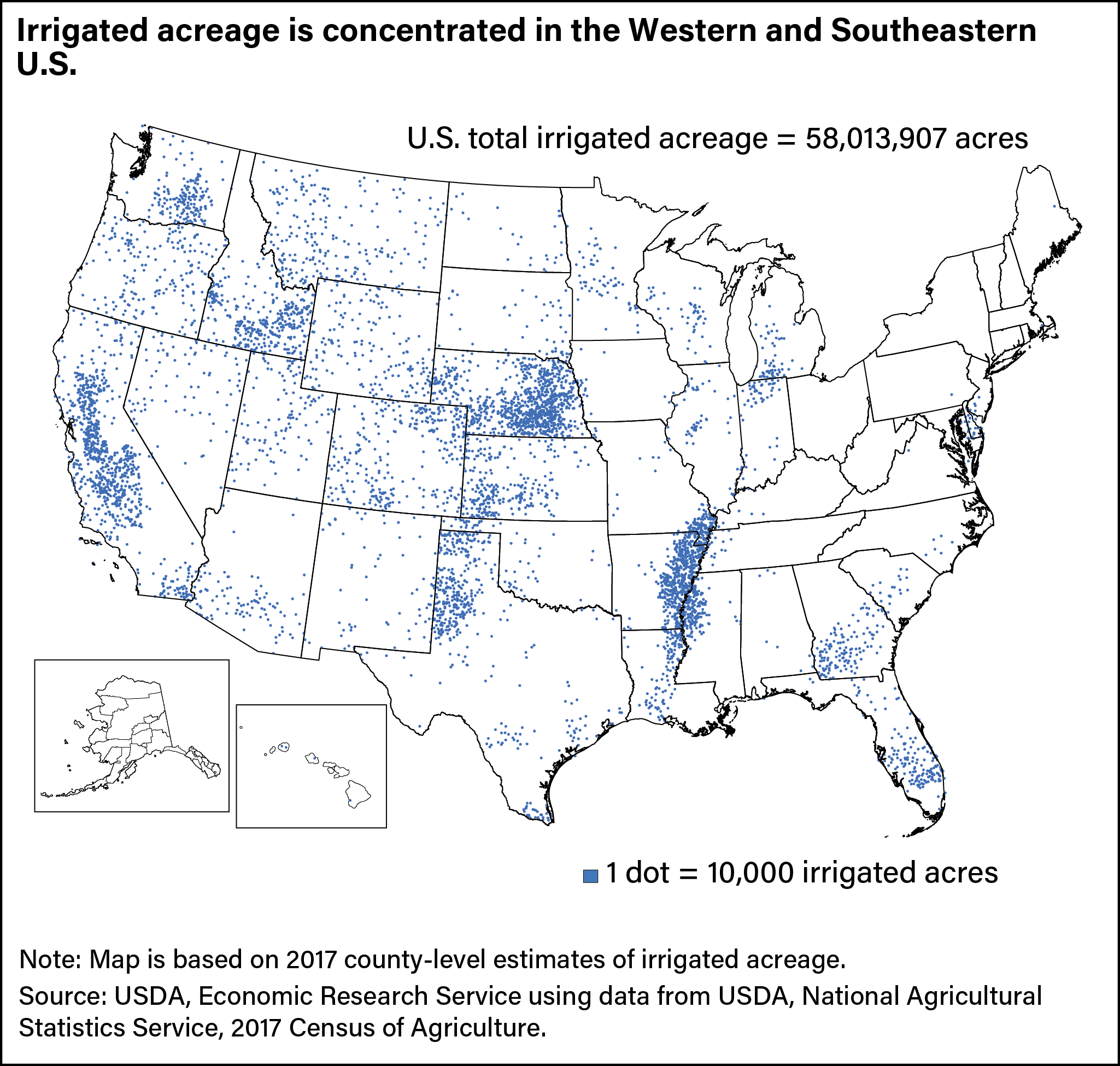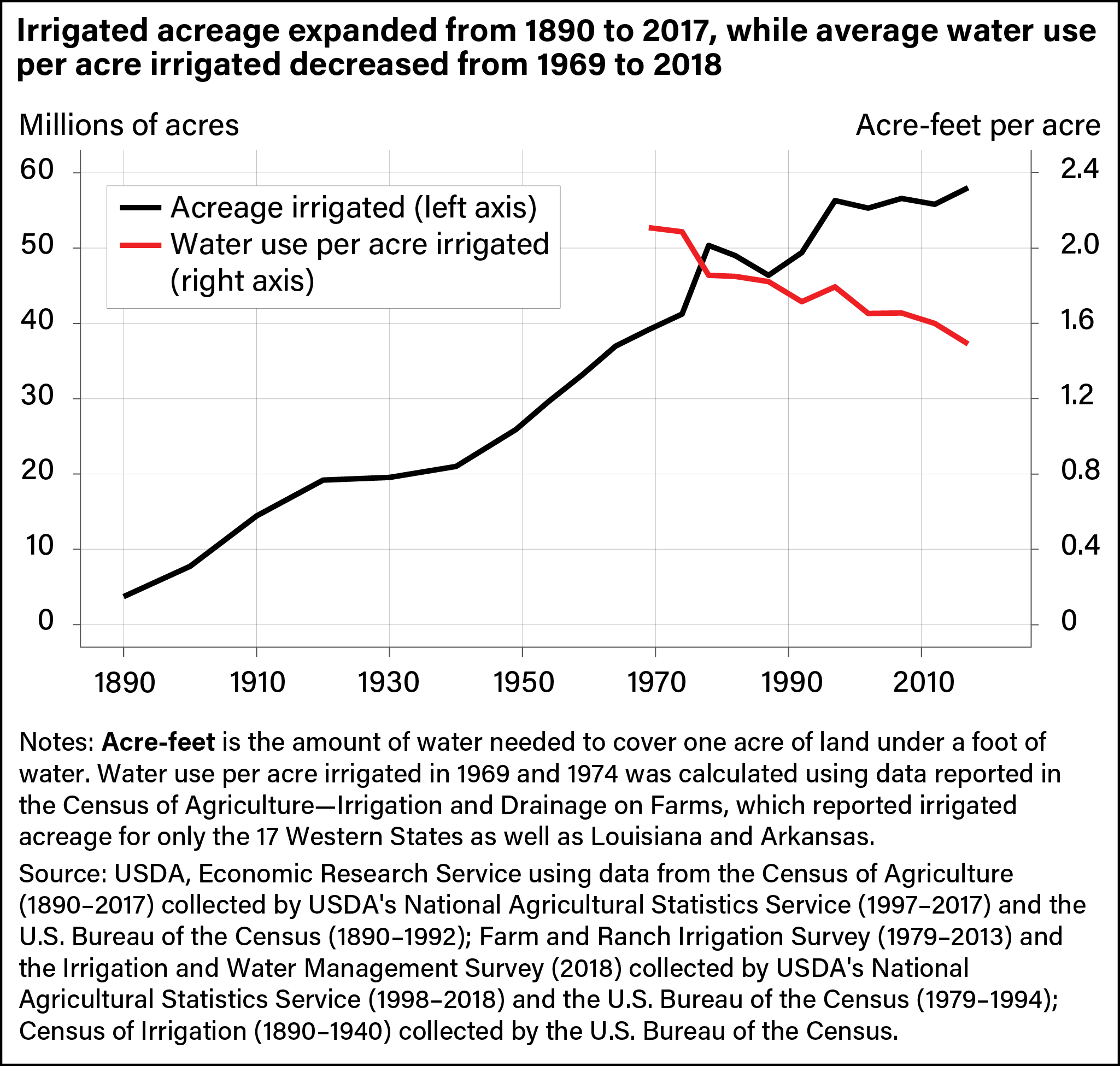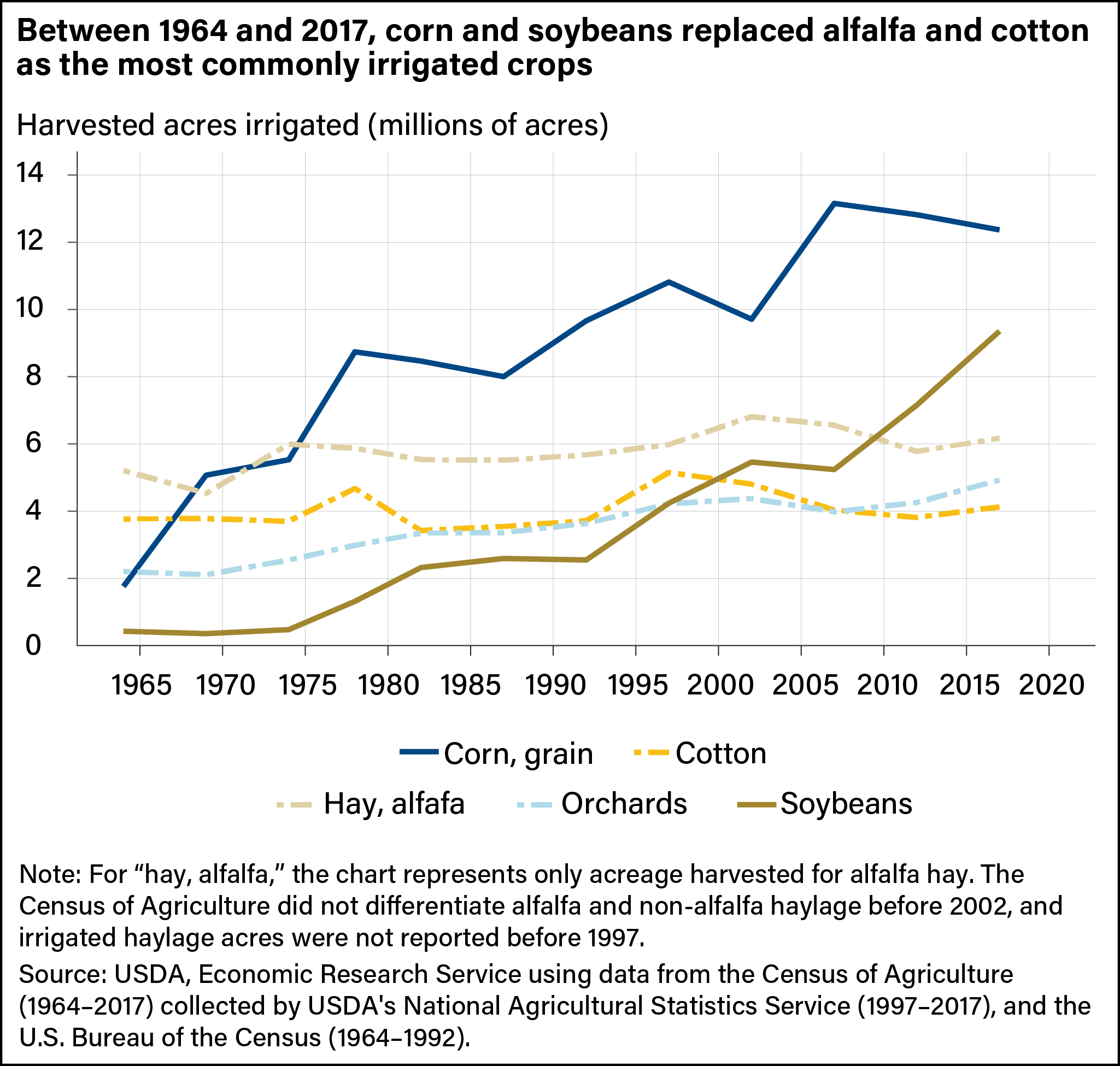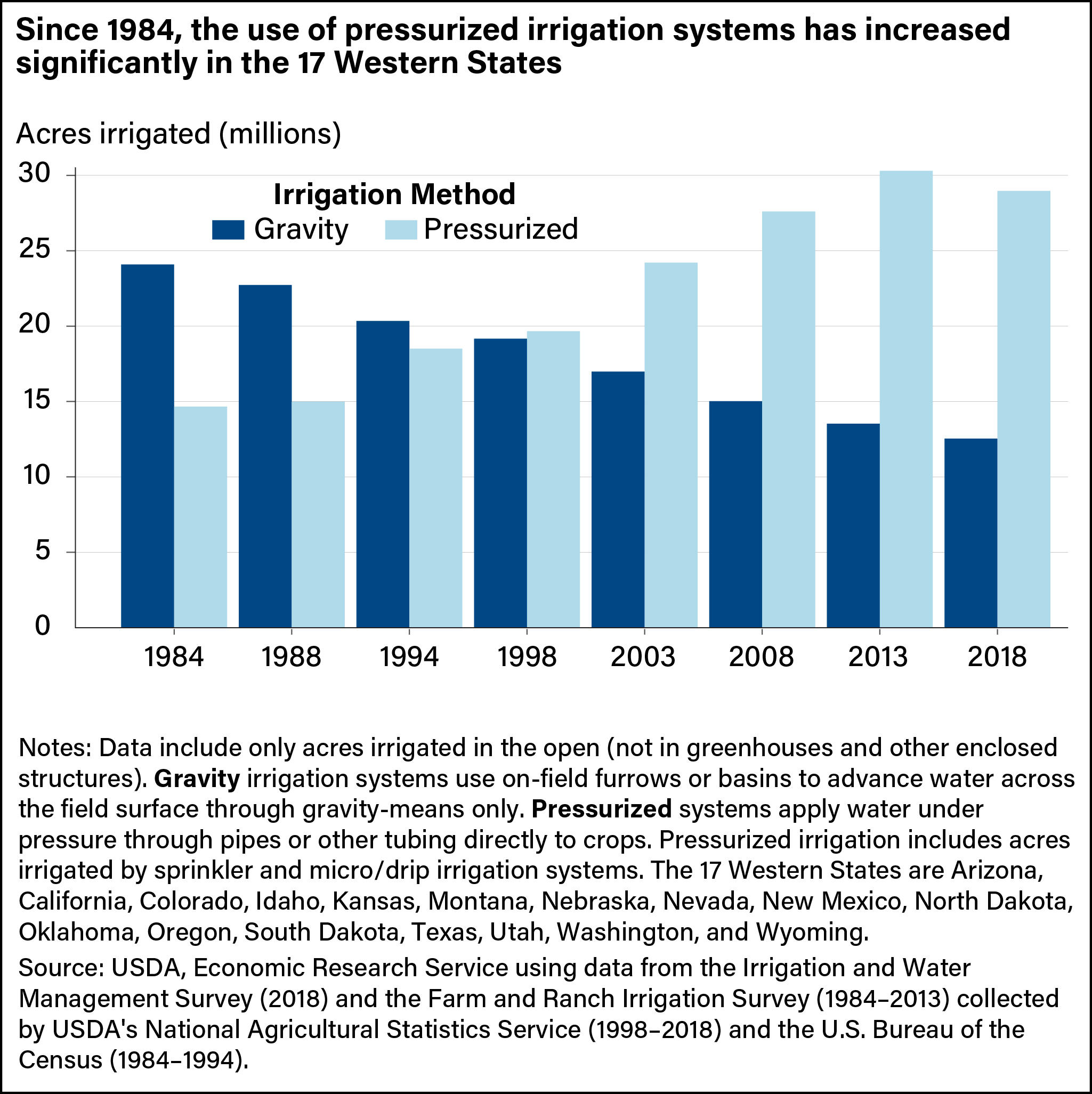
Trends in Irrigated Agriculture Reveal Sector’s Ability To Adapt to Evolving Climatic, Resource, and Market Conditions
- by R. Aaron Hrozencik and Marcel Aillery
- 1/12/2022
Highlights
- Irrigated acreage has expanded rapidly since the passage of the Federal Reclamation Act of 1902. Nationwide, irrigated acreage grew from less than 3 million acres in 1890 to more than 58 million acres in 2017.
- Between 1949 and 2017, the share of U.S. irrigated cropland within the Mountain and Pacific regions decreased from 77 percent to 44 percent, while the share of irrigated cropland in the Mississippi Delta and Northern Plains regions increased from 8 percent to 34 percent.
- In the Pacific, Mountain, and Northern and Southern Plains regions, the share of irrigated acres using pressurized systems rose from 37 percent in 1984 to 72 percent in 2018, with innovations focused on improved precision of applied water, reduced pressurization requirements, and system automation.
Irrigation is a vital part of the U.S. agricultural economy. In 2017, irrigated farms produced more than 54 percent of the total value of crop sales. Irrigation allows for agricultural production in arid regions where precipitation is insufficient to meet plant water requirements. In more humid regions with variable growing-season rainfall, applied irrigation water supplements available soil moisture and provides a critical buffer against periodic drought.
However, increasing competition for water supplies, declining groundwater reserves, and shifts in climatic conditions and hydrologic flows are taxing the ability of regional water systems to meet irrigation needs. Projected increases in the frequency and severity of droughts have important implications for future agricultural water demand and supply. The resiliency of irrigated agriculture will depend on how farmers, and the institutions that influence water supply and use, adapt to increasing water scarcity.
Water availability, climate, and growing-season weather conditions largely determine where cropland is irrigated. Irrigation is most common in the arid Western United States, where major water infrastructure projects store and transport the region’s surface water resources. Publicly financed reclamation investments in reservoirs and canal networks allow high-value agricultural production in regions such as the Central Valley of California, south-central Washington, and the Snake River Valley of Idaho. In the Ogallala Aquifer region of the Northern and Southern Plains, concentrations of irrigated acreage reflect the availability of groundwater resources. Irrigation also occurs in the more humid Eastern United States, with the largest irrigated acreage concentrations in the Mississippi Delta, southern Georgia, and central Florida. In these regions, irrigation is primarily used to supplement rainfall to minimize production risks associated with variable weather conditions.
Irrigated acreage in the United States has grown from fewer than 3 million acres in 1890 to more than 58 million acres in 2017, accounting for approximately 15 percent of the 396 million acres of total U.S. cropland. This expansion has contributed significantly to cropland productivity. While the total irrigated land area steadily increased, the average amount of water applied per irrigated acre fell from more than 2 acre-feet per acre irrigated in 1969 to less than 1.5 acre-feet per acre irrigated in 2018. The diminishing intensity of water use per acre reflects changes in on-farm irrigation conveyance and application technologies, as well as shifts in regional irrigated area and evolving crop patterns.
Aggregate trends in U.S. irrigated land mask important variations across regions, with implications for the resilience of the agricultural sector. After the mid-20th century, irrigation gradually shifted eastward, as the amount of irrigated land decreased across the West and expanded in the East. Between 1949 and 2017, the share of total U.S. irrigated cropland in the Mountain and Pacific regions decreased from 77 percent to 44 percent, while the share of irrigated cropland in the Mississippi Delta and Northern Plains regions increased from 8 percent to 34 percent. Acreage declines in traditionally irrigated areas of the Western United States reflect increasing regional competition for available water supplies, changes in surface flow regimes largely reliant on mountain snowpack melt, and diminishing groundwater availability. Meanwhile, irrigation has continued to expand in the Eastern United States, reflecting access to relatively shallow groundwater aquifers and incentives to minimize soil-moisture deficits during critical crop growth stages, particularly during periods of drought.
Over the past half century, irrigated cropping patterns have shifted significantly as corn and soybeans replaced alfalfa and cotton as the most commonly irrigated crops. Corn and soybeans have become increasingly important as livestock feed. In addition, roughly a third of U.S. corn production is dedicated to ethanol production, and soybeans serve as an important biodiesel feedstock. The transition to irrigated corn and soybeans has potential water use implications at a national scale. These crops tend to use less water per acre irrigated on average than some previously dominant crops, such as alfalfa. Site-specific impacts on water withdrawals depend on local shifts in irrigated cropping patterns, as well as changes in total land irrigated.
In recent decades, the irrigation sector has experienced a significant change in the technologies used to irrigate crops. Irrigation application technologies can be broadly categorized as either gravity or pressurized systems. Gravity irrigation systems use on-field furrows or basins to advance water across the field surface through gravity only, while pressurized systems (such as center pivot sprinklers) apply water under pressure through pipes or other tubing directly to crops. The use of pressurized irrigation application systems, which are generally more water-use efficient than gravity-flow systems in most field settings, has increased significantly. This shift was especially pronounced in the Western United States, where the share of irrigated acres using pressurized systems rose from 37 percent (15 million acres) in 1984 to 72 percent (29 million acres) in 2018. Federal programs such as the Environmental Quality Incentives Program (EQIP), administered by USDA’s Natural Resources Conservation Service (NRCS), have supported irrigation efforts during this transition. EQIP provides financial and technical assistance to encourage the adoption of more efficient irrigation technologies and water management practices (such as soil-moisture monitoring) that enhance the agricultural sector’s resilience to drought and long-term water scarcity.
In addition to improvements in water-use efficiency, USDA supports the resiliency of the irrigated agricultural sector through measures that enhance water-supply security in areas facing shortfalls because of drought and long-term water scarcity. For example, the Conservation Reserve Enhancement Program administered by the USDA, Farm Service Agency works with States to offer financial incentives to producers that voluntarily retire irrigated land and associated water rights in water-stressed basins. Additionally, the NRCS’ Regional Conservation Partnership Program provides funding to coordinate drought resiliency initiatives at the regional or basin level with State and local stakeholders.
This article is drawn from:
- Hrozencik, R.A. & Aillery, M. (2021). Trends in U.S. Irrigated Agriculture: Increasing Resilience Under Water Supply Scarcity. U.S. Department of Agriculture, Economic Research Service. EIB-229.
You may also like:
- Rosenberg, A.B. (2020, October 5). Incentives to Retire Water Rights Have Reduced Stress on the High Plains Aquifer. Amber Waves, U.S. Department of Agriculture, Economic Research Service.
- Risk Management. (n.d.). U.S. Department of Agriculture, Economic Research Service.
- Wang, S.L., Nehring, R. & Williams, R. (2019, August 12). Climate Change Likely to Have Uneven Impacts on Agricultural Productivity. Amber Waves, U.S. Department of Agriculture, Economic Research Service.
- Climate Change. (n.d.). U.S. Department of Agriculture, Economic Research Service.
- Irrigation & Water Use. (n.d.). U.S. Department of Agriculture, Economic Research Service.
- Wallander, S., Marshall, E. & Aillery, M. (2017, June 5). Farmers Employ Strategies To Reduce Risk of Drought Damages. Amber Waves, U.S. Department of Agriculture, Economic Research Service.
- Hrozencik, R.A., Wallander, S. & Aillery, M. (2021). Irrigation Organizations: Water Storage and Delivery Infrastructure. U.S. Department of Agriculture, Economic Research Service. EB-32.
- Wallander, S., Hrozencik, R.A. & Aillery, M. (2022). Irrigation Organizations: Drought Planning and Response. U.S. Department of Agriculture, Economic Research Service. EB-33.
- McFadden, J., Smith, D., Wechsler, S.J. & Wallander, S. (2019). Development, Adoption, and Management of Drought-Tolerant Corn in the United States. U.S. Department of Agriculture, Economic Research Service. EIB-204.
- Crane-Droesch, A., Marshall, E., Rosch, S., Riddle, A., Cooper, J. & Wallander, S. (2019). Climate Change and Agricultural Risk Management Into the 21st Century. U.S. Department of Agriculture, Economic Research Service. ERR-266.






